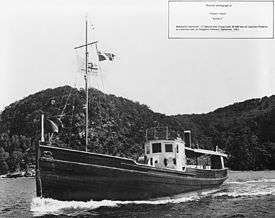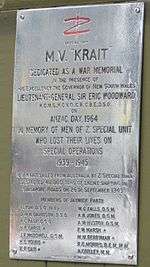Operation Jaywick
| Operation Jaywick | |||||||
|---|---|---|---|---|---|---|---|
| Part of the Japanese occupation of Singapore during World War II | |||||||
.jpg) The MV Krait, used to infiltrate Singapore. | |||||||
| |||||||
| Belligerents | |||||||
|
| Z Special Unit | ||||||
| Commanders and leaders | |||||||
| N/A |
| ||||||
| Strength | |||||||
| N/A |
14 commandos and sailors 1 fishing boat | ||||||
| Casualties and losses | |||||||
| 7 ships sunk | None | ||||||
Operation Jaywick was a special operation undertaken in World War II. In September 1943, 14 commandos and sailors from the Allied Z Special Unit raided Japanese shipping in Singapore Harbour, sinking seven ships.
Background

Special Operations Australia (SOA), a joint Allied military intelligence organisation, was established in March 1942. SOA operated under the cover name Inter-Allied Services Department (IASD). It contained several British SOE officers who had escaped from Japanese occupied Singapore, and they formed the nucleus of the IASD, which was based in Melbourne. In June 1942, a commando arm was organised as Z Special Unit (which was later commonly known as Z Force). It drew its personnel primarily from the Australian Army and Royal Australian Navy.
In 1943, a 28-year-old British officer, Captain Ivan Lyon (of the Allied Intelligence Bureau and Gordon Highlanders), and a 61-year-old Australian civilian, Bill Reynolds, devised a plan to attack Japanese shipping in Singapore Harbour. Commandos would travel to the harbour in a vessel disguised as an Asian fishing boat. They would then use folboats (collapsible canoes) to attach limpet mines to Japanese ships.
Reynolds was in possession of a 21.3-metre (70 ft) Japanese coastal fishing boat, the Kofuku Maru, which he had used to evacuate refugees from Singapore. Lyon ordered that the boat be shipped from India to Australia. Upon its arrival, he renamed the vessel MV Krait, after the small but deadly Asian snake.
The attack


In mid-1943, the Krait travelled from a training camp at Broken Bay, New South Wales to Thursday Island. Aboard was a complement from Z Special Unit of three British and eleven Australian personnel, comprising:
- Major Ivan Lyon (Mission Commander)
- Lieutenant Hubert Edward Carse (Krait's Captain)
- Lieutenant Donald Montague Noel Davidson
- Lieutenant Robert Charles Page
- Corporal Andrew Anthony Crilly
- Corporal R.G. Morris
- Leading Seaman Kevin Patrick Cain
- Leading Stoker James Patrick McDowell
- Leading Telegraphist Horace Stewart Young
- Able Seaman Walter Gordon Falls
- Able Seaman Mostyn Berryman
- Able Seaman Frederick Walter Lota Marsh
- Able Seaman Arthur Walter Jones
- Able Seaman Andrew William George Huston
On 13 August 1943, the Krait left Thursday Island for the U.S. Naval Base at Exmouth Gulf, Western Australia, where it was refuelled and repairs were undertaken.
On 2 September 1943, the Krait left Exmouth Gulf and departed for Singapore. The team's safety depended on maintaining the disguise of a local fishing boat. The men stained their skin brown with dye to appear more Asiatic and were meticulous in what sort of rubbish they threw overboard, lest a trail of European garbage arouse suspicion. After a relatively uneventful voyage, the Krait arrived off Singapore on September 24. That night, six men left the boat and paddled 50 kilometres (31 mi) with folboats (collapsible canoes) to establish a forward base in a cave on a small island near the harbour. On the night of 26 September 1943, they paddled into the harbour and placed limpet mines on several Japanese ships before returning to their hiding spot.
In the resulting explosions, the limpet mines sank or seriously damaged seven Japanese ships, comprising over 39,000 tons between them.[1] The commandos waited until the commotion over the attack had subsided and then returned to the Krait, which they reached on 2 October. Their return to Australia was mostly uneventful, except for a tense incident in the Lombok Strait when the ship was closely approached by a Japanese patrol boat; however the Krait was not challenged. On October 19, the ship and crew arrived safely back at Exmouth Gulf.
Raid repercussions

The raid took the Japanese authorities in Singapore completely by surprise. Never suspecting such an attack could be mounted from Australia, they assumed it had been carried out by local saboteurs, most likely pro-Communist Chinese guerillas. In their efforts to uncover the perpetrators, a wave of arrests, torture and executions began. Local Chinese and Malays, as well as interned POWs and European civilians were targeted in this programme. The incident became known as the Double Tenth, for 10 October, the day that Japanese secret police began the mass arrests.
Given the misery visited upon the local population by the Japanese, criticism has arisen as to whether Operation Jaywick was justified, especially with its relatively limited strategic results. In the aftermath of the raid, the Allies never claimed responsibility for the attack on shipping, most likely because they wanted to preserve the secret of the Krait for future similar missions. Therefore the Japanese did not divert significant military resources to defending against such attacks, instead just using their secret police to enact reprisals against civilians.
Operation Jaywick was followed by Operation Rimau. Three ships were sunk, but the participants, including Lyon, were killed or captured and executed.
See also
References
External links
- Australian Department of Veterans Affairs, 2003, "Operation Jaywick, 60th Anniversary"
- Peter Dunn, 2005, "'Z' Special Unit in Australia During WW2" (ozatwar.com)
- Interview with Horrie Young in the Australians At War Film Archive
- HNSA Ship Page: Krait
- Operation Jaywick, Australian War Memorial
Coordinates: 1°17′14.45″N 103°51′55.32″E / 1.2873472°N 103.8653667°E